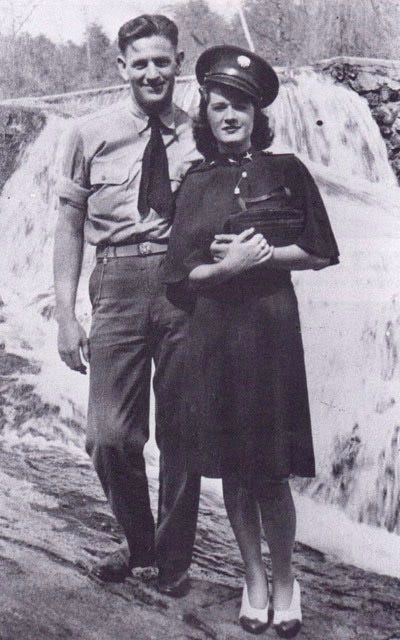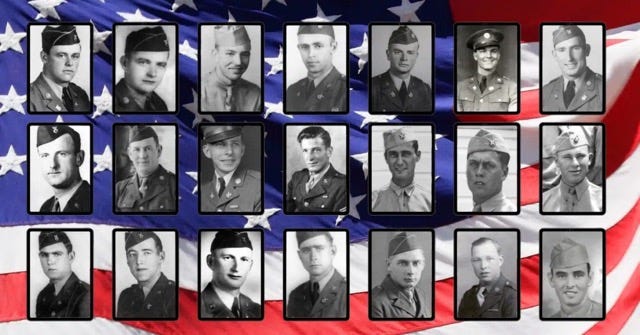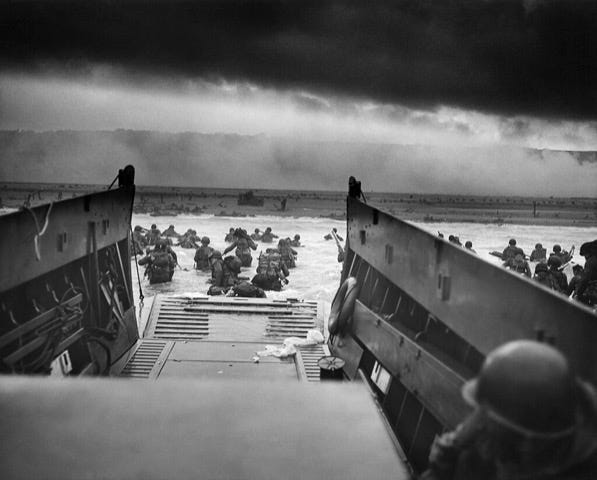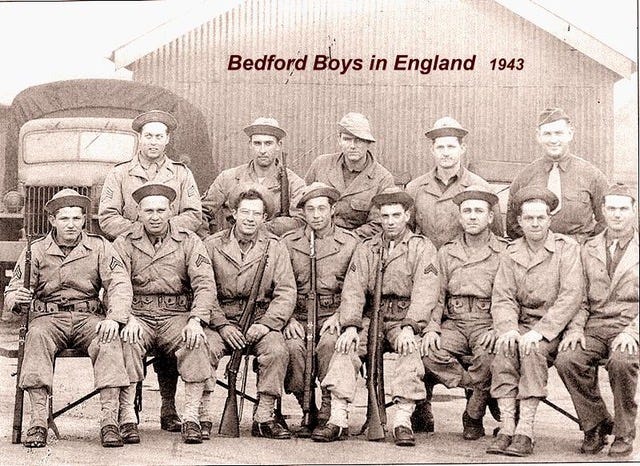ONE WOMAN'S ULTIMATE D-DAY SACRIFICE.
On 6 June 1944, Bettie Wilkes lost her husband, Master Sergeant John Wilkes, one of 20 “Bedford Boys” killed on D Day.
Not long after 9/11, I interviewed Bettie for my book, The Bedford Boys: One Small Town’s Ultimate D Day Sacrifice, published in 2003. Several years later, I returned to Bedford, Virginia, and spoke to her once more.

Bettie and John Wilkes were married in 1941. By June 1944, Wilkes was a muscle-bound, tough Master Sergeant in A Company of the 116th Infantry Regiment. Within minutes of landing on Omaha Beach, Wilkes and more than half of A Company had been slaughtered – suffering the highest fatalities of any Allied unit on D Day. The opening minutes of Saving Private Ryan show this tragedy in vivid detail.
Bettie was an utterly gracious woman, a deeply proud Virginian, and I will be forever grateful to her for her courage and honesty in sharing the tragic events of summer 1944 with me. I last met her, in Bedford, several months before she passed away, age 90, in 2014. Her husband’s grave is in Greenwood Cemetery in Bedford, Virginia.
As this year’s anniversary of D Day approached, I thought it would be appropriate to honor her and her husband, and indeed their generation, by telling her story in her own words:
“How did we find out that the boys were finally shipping out to England [in October 1942]? One of the boys must have gotten a phone call through to Bedford, and we got word of it. My friend Viola, whose husband Earl Parker served in Company A with my husband, called me and said, “Well, do you want to go to New York?” I replied, “Well, I guess so.” Her dad drove us to the station in Bedford.”

“We caught a train out the next week in the evening. It was crazy. But I had said I would see John any way I could. Of course, we couldn’t get a call through from our hotel in New York. We tried and tried. The next day we decided to try returning to Bedford.”
“I lived in Bedford with my sister Mildred. We shared an apartment, and she was very important to me. We worked together, and she was five years older than I. I was 21 when John was killed. When I learned about his death, I didn’t want to go back to work [at Belding Hemingway, which produced parachutes for the 101st Airborne Division and others].”
“After I received the telegram [on 17 July, six weeks after D Day], about a week later, my sister said, “I’m not going back to work until you go.” I guess that pushed me. I didn’t want her to lose her job because of me, and I didn’t want to lose mine either. Having something to do helped.”
“Viola Parker, who also lost her husband Earl on D Day, was close to me. We talked probably every night. Viola would always say about Earl, “when he comes back…” She wouldn’t accept that he had been lost. I just listened, not wanting to tell her he wasn’t coming back. She went to see [Lieutenant] Nance [who had been on Omaha Beach], and he told her Earl had been killed and then she finally accepted his death. She was trying to keep hope alive, and I didn’t want to take that away from her.”
“I was with Viola the night Danny [her daughter with Earl] was born in 1943. Her mother was over at the hospital and called me. Viola had taken a pencil and paper with her to the hospital. After giving birth, they brought her back to her room, and I was there. She soon started looking for a little drawer in the bedside table. She pulled out the paper and pencil and tried to sit up to write to Earl just a few hours after giving birth. We tried to get her to go back to sleep.”

“I went to Normandy for the 40th anniversary of D-Day in 1984. I met a medic, Cecil Breeden, who had landed in the first wave with my husband, John. We first met at Dulles airport while boarding a flight. He helped me with my luggage and asked where I was from. His eyes widened when I said I was from Bedford. In Normandy, he took me down to the beach and showed me where he had found John’s body. He said John hadn’t suffered—he was shot through the forehead.”
“I had John’s body brought back to Bedford in 1947. I felt better knowing he wanted to come home. There was some closure there; I had brought him home. His mother and father are buried right behind him now, and his sister too. When we saw the coffin, his father said to me, “I feel sure that’s him, don’t you?” I replied, “Oh yeah.” We could not be certain, as we weren’t allowed to open the coffin.”
“I still have John’s ring [over sixty years later]...the wedding ring. It’s in a necklace I wear. The photo shows me near a waterfall. It was a Sunday, on our honeymoon in 1941. I was eighteen.”
Bettie remarried after the war. In addition to her husband, John, eight Bedford Boys rest today in eternal peace at Greenwood Cemetery in Bedford. Eleven others from the small town, who died on June 6, are buried or commemorated on the Wall of the Missing at Colleville-sur-Mer American cemetery, overlooking the beach where they lost their lives.
This piece appears courtesy of Friends of the National WW2 Memorial. Please support us at: https://www.wwiimemorialfriends.org/our-mission








Some great pieces you've posted Alex and I’m with you all the way on commemorating the bravery of all those who fought in what in Britain we call the Second World War that for us lasted from 1939 to 1945. However as a Brit could I be so bold to offer a comment.
D Day was an 'Allied' forces invasion of five Normandy beaches, not by the US alone at Omaha and Utah. Countries involved in the liberation of Europe in varying proportion and capacity were : Britain, Canada, USA, Poland, Netherlands, Belgium, France, Norway, Czech and several others.
Frederick Morgan was the British head of the department which drew up the original C.O.S.S.A.C. invasion plan for Normandy, which Montgomery later revised and expanded upon and after which was known as, B.I.G.O.T. to include American involvement on two extra beaches located further west than originally planned. The USA was certainly involved in the planning for D Day particularly regarding US forces, but to a lesser extent overall than the British due to the fact that everything relied on British intelligence and knowledge of our own theatre of war. The plan relied upon British knowledge of the seas and the European mainland, British intelligence, counter intelligence and espionage, British code breaking (from Bletchley Park), along with the British spy network, cross and double cross and subterfuge that were all part of Operation Bodyguard which also incorporated Operations Fortitude North and Fortitude South). 85% of the seaborne Operation Neptune used Royal Navy assets and personnel, roughly 60% of air operations used Royal Air Force assets and personnel. Let's also not overlook the British ingenuity on such things as the two Mulberry Harbours (huge portable docks for resupply shipping), Hobarts Funny’s (specialised tanks), PLUTO (undersea fuel pipeline) and the indispensable, ubiquitous Bailey bridge.
And let's also not forget that the the pre-invasion buildup and start point for the invasion came from a Britain that had held fast despite standing alone against Nazi aggression for two years.
Eisenhower as SAC was American, but his second in command Arthur Tedder was British and the chief commanders of all invasion forces : Air Marshal Trafford Leigh Mallory (Air forces), Admiral Bertram Ramsay (Naval forces), and General Bernard Montgomery (Land forces), were British.
The combined allied invasion took place on Normandy beaches covering a stretch of coast roughly 56 miles wide east to west, named, from the east : Sword (Brit), Juno (Can), Gold (Brit), Omaha (US), Utah (US). There were also three airborne landings to take place during the night of 5/6 June, by the British 6th airborne in the east, and by the US 101st & 82nd airborne in the west.
British and Canadian, and later also Polish, armoured divisions were tasked with containing and destroying the eight German armoured divisions located in the Pas de Calais to the east, which allowed US forces to take and occupy the Cotentin peninsular and the port of Cherbourg.
Many brave people,both those in uniform and civilians lost their lives in seeking to free Europe from Nazi domination and we in Europe will be forever grateful to the sacrifice of the US personnel who fought and in many cases died in achieving such freedom.
As we say in Britain... lest we forget .. and that includes the sacrifice of all, of whatever nation, sex, colour and creed … we must never forget all who paid the ultimate sacrifice.
I’m reading your book now. Powerful stories.